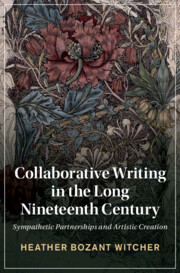Book contents
- Collaborative Writing in the Long Nineteenth Century
- Cambridge Studies in Nineteenth-Century Literature and Culture
- Collaborative Writing in the Long Nineteenth Century
- Copyright page
- Dedication
- Contents
- Figures
- Acknowledgments
- Introduction
- Chapter 1 Adam Smith’s Liberal Sympathy
- Chapter 2 “O You Pretty Pecksie!”
- Chapter 3 Written–Visual Aesthetics
- Chapter 4 Typographical Adventures
- Chapter 5 Sim and Puss
- Chapter 6 Towards Empathy
- Conclusion
- Notes
- Bibliography
- Index
- Cambridge Studies in Nineteenth-Century Literature and Culture
Introduction
Published online by Cambridge University Press: 12 March 2022
- Collaborative Writing in the Long Nineteenth Century
- Cambridge Studies in Nineteenth-Century Literature and Culture
- Collaborative Writing in the Long Nineteenth Century
- Copyright page
- Dedication
- Contents
- Figures
- Acknowledgments
- Introduction
- Chapter 1 Adam Smith’s Liberal Sympathy
- Chapter 2 “O You Pretty Pecksie!”
- Chapter 3 Written–Visual Aesthetics
- Chapter 4 Typographical Adventures
- Chapter 5 Sim and Puss
- Chapter 6 Towards Empathy
- Conclusion
- Notes
- Bibliography
- Index
- Cambridge Studies in Nineteenth-Century Literature and Culture
Summary
The Introduction examines the process of “sympathetic collaboration” – drawing from manuscript marginalia, notes, journal/diary entries, and correspondence – and the influences of that process on poetry, drama, and fiction. Guided by the current trend of literary studies around sympathy, emotion, and affect, it demonstrates the long reach that eighteenth-century moral philosophy has on later literature and artistic thought by investigating the writing and creative processes to understand the ways in which communal relationships are inscribed within the literary product. Collaboration is necessarily rooted in the ideals of Victorian liberalism: It is derived from a representation of sympathetic identification and emphasizes human sociability. In a broader sense, this book provides a fresh understanding of literary collaboration necessarily informed by the mechanics of the writing process and illustrated in the formal elements of literature, as well as textual or marginal traces within the manuscripts. Nineteenth-century artistic creation is, I propose, rooted in sympathetic identification. This philosophical approach to life (seen in the lived attempts at community for each of my case studies) has larger implications for literary history: I suggest that these sympathetic communities are mutually implicated in formal experimentation and innovation.
- Type
- Chapter
- Information
- Collaborative Writing in the Long Nineteenth CenturySympathetic Partnerships and Artistic Creation, pp. 1 - 12Publisher: Cambridge University PressPrint publication year: 2022

